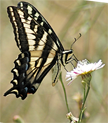 The pale swallowtail or Papilio eurymedon, which is also called the pallid swallowtail, is a butterfly in the Papilionidae family and the Papilioninae subfamily. It is found in San Bernardino County, and is common throughout much of western North America, particularly along the Pacific coast from northern Baja California to southernmost British Columbia. Its territory reaches inland to northern New Mexico, Colorado, Wyoming, Montana and as far east as the Black Hills of South Dakota. It is absent from most of Nevada and western Utah.
The pale swallowtail or Papilio eurymedon, which is also called the pallid swallowtail, is a butterfly in the Papilionidae family and the Papilioninae subfamily. It is found in San Bernardino County, and is common throughout much of western North America, particularly along the Pacific coast from northern Baja California to southernmost British Columbia. Its territory reaches inland to northern New Mexico, Colorado, Wyoming, Montana and as far east as the Black Hills of South Dakota. It is absent from most of Nevada and western Utah.
The pale swallowtail prefers open woodlands, forest clearings, foothills and chaparral, especially near permanent bodies of water such as ponds and streamsides, but also urban parks. They are occasionally seen in suburban areas. Though not as common as the western tiger swallowtail, the pale swallowtail can be seen in large numbers at puddling parties where up to a dozen or more males may be gathered. There they join other species to sip water from damp soil to obtain nutrients for mating.
Their appearance is quite similar to that of the western tiger swallowtail, except they are a white-cream color or very pale yellow. Some pale swallowtails also have differing amounts of red-orange patches on the wings just above the tail. Tiger stripes and borders are thicker than those of western tiger swallowtails. The wingspan is typically 2.8 to 4.5 inches. The front wing is narrow and pointed; the tail of hindwing is long, slender and twisted.
Males perch and patrol for receptive females. Females lay eggs singly on host plant leaves, which include members of the Ceanothus genus, including buckbrush, mountain balm, and mountain lilac, trees and shrubs in the Rosaceae, Rhamnaceae and Betulaceae families including cherry (Prunus emarginata), bitter cherry coffee-berry (Rhamnus californica), and ash (Fraxinus spp.), as well as red alder, ocean spray, and serviceberry species. Caterpillars feed on leaves and rest on silken mats in shelters of curled leaves. The pale swallowtail has a single brood throughout most of its range, but two or more along the Pacific Coast. Adults fly from March to October and are most common in May and July. In southern California, they fly from March until August. Caterpillars enter their pupal stage in the fall. Pupae hibernate and overwinter before emerging as adults.
Adults feed on flower nectar, including that of the California buckeye, yerba santa, and wallflower.
Caterpillars are plump green with a single yellow band behind the thorax. The have two eye-shaped spots on the upper thorax, which may help frighten predators. Like most swallowtails, they have a red wishbone-shaped organ called the osmeterium, which pops out from behind the head and releases a foul odor to warn off predators. Caterpillars turn brown just before the fifth moult. The pupa is brown and looks like a piece of bark. As they pupate, they face upright, secure the tip of their abdomens to a branch with a silk thread, and hang freely.
SBCSentinel
News of note from around the largest county in the lower 48 states.
